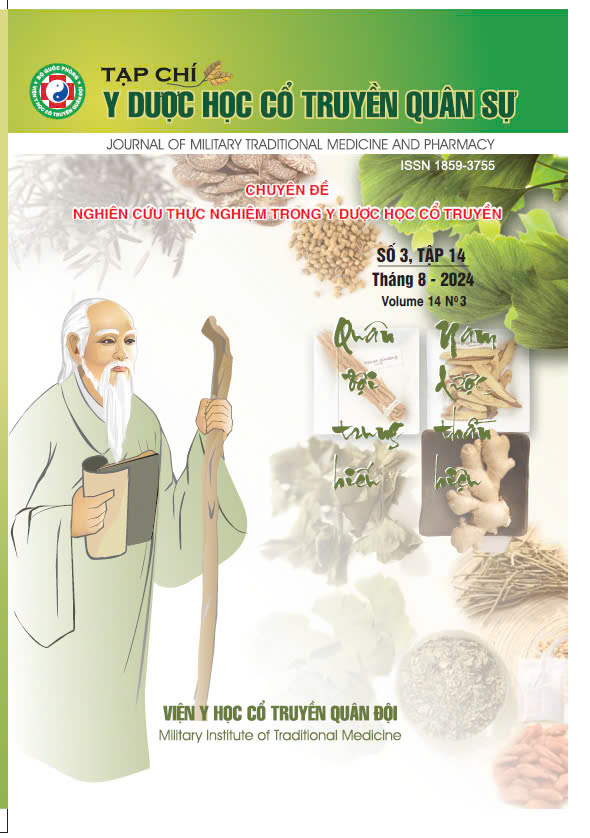VAI TRÒ CỦA THỎ TRONG NGHIÊN CỨU TÍNH AN TOÀN VÀ TÁC DỤNG TRÊN SINH SẢN ĐỰC CỦA THUỐC Y HỌC CỔ TRUYỀN
Main Article Content
Abstract
Among the animals models commonly used in research, rabbits are the third commonly used after mice and rats, and there are many advantages when using rabbits as research subjects in toxicity and male reproductive studies. When using rabbits as research subjects, attention should be paid to the age of the rabbits; the duration of drug administration; the markers that need to be evaluated; and it is necessary to standardize the care process to limit the influence of experimental conditions.
Article Details
Keywords
Rabbit model, toxicity, male reproductive.
References
1. Bernd F., Pascale C. P., Christopher V., et al. (2012) Rabbit as a reproductive model for human health. Reproduction, 144(1): 1-10.
2. OECD (2018) Test No. 452: Chronic Toxicity Studies.
3. Đinh Quốc Hưng, Phạm Xuân Phong, Hà Xuân Minh và cs. (2023) "Nghiên cứu độc tính cấp, độc tính bán trường diễn của viên nang nhất gan linh trên động vật thực nghiệm". Tạp chí Y học Việt Nam, 532(2): 308-313.
4. Khalifa A. W. H., El-Sisy G. A., El-Nattat W. S., et al. (2018) Effect of water extract of dates palm (Phoenix dactylifera) on semen characteristics and oxidative status in serum of male New Zealand rabbits under heat stress. Asian Pacific Journal of Reproduction, 7(1): 22-26.
5. Marco-Jiménez F. and Vicente J. S. (2017) Overweight in young males reduce fertility in rabbit model. PLoS One, 12(7): e0180679.
6. Zakaria A., Aida E. B., Sherief M. A. R., et al. (2017) Effect of inhibition of estrogen synthesis or blocking its receptors on male rabbit reproduction Indian Journal of Pharmaceutical and Biological Research, 5(1): 34-41.
7. Attia Y. A., Hamed R. S., Bovera F., et al. (2017) Semen quality, antioxidant status and reproductive performance of rabbits bucks fed milk thistle seeds and rosemary leaves. Animal Reproduction Science, 184(178-186.
8. International rabbit reproduction group (2005) Guidelines for the handling of rabbit bucks and semen. World Rabbit Science Journal, 13(71-91).
9. OECD (2018) Test No. 408: Repeated Dose 90-Day Oral Toxicity Study in Rodents.
10. OECD (2011) Test No. 443: Extended One-Generation Reproductive Toxicity Study.
11. Johinke D., De Graaf S. P. and Bathgate R. (2014) Investigation of in vitro parameters and in vivo fertility of rabbit spermatozoa after chilled storage. Animal Reproduction Science, 147(3): 135-143.
2. OECD (2018) Test No. 452: Chronic Toxicity Studies.
3. Đinh Quốc Hưng, Phạm Xuân Phong, Hà Xuân Minh và cs. (2023) "Nghiên cứu độc tính cấp, độc tính bán trường diễn của viên nang nhất gan linh trên động vật thực nghiệm". Tạp chí Y học Việt Nam, 532(2): 308-313.
4. Khalifa A. W. H., El-Sisy G. A., El-Nattat W. S., et al. (2018) Effect of water extract of dates palm (Phoenix dactylifera) on semen characteristics and oxidative status in serum of male New Zealand rabbits under heat stress. Asian Pacific Journal of Reproduction, 7(1): 22-26.
5. Marco-Jiménez F. and Vicente J. S. (2017) Overweight in young males reduce fertility in rabbit model. PLoS One, 12(7): e0180679.
6. Zakaria A., Aida E. B., Sherief M. A. R., et al. (2017) Effect of inhibition of estrogen synthesis or blocking its receptors on male rabbit reproduction Indian Journal of Pharmaceutical and Biological Research, 5(1): 34-41.
7. Attia Y. A., Hamed R. S., Bovera F., et al. (2017) Semen quality, antioxidant status and reproductive performance of rabbits bucks fed milk thistle seeds and rosemary leaves. Animal Reproduction Science, 184(178-186.
8. International rabbit reproduction group (2005) Guidelines for the handling of rabbit bucks and semen. World Rabbit Science Journal, 13(71-91).
9. OECD (2018) Test No. 408: Repeated Dose 90-Day Oral Toxicity Study in Rodents.
10. OECD (2011) Test No. 443: Extended One-Generation Reproductive Toxicity Study.
11. Johinke D., De Graaf S. P. and Bathgate R. (2014) Investigation of in vitro parameters and in vivo fertility of rabbit spermatozoa after chilled storage. Animal Reproduction Science, 147(3): 135-143.


